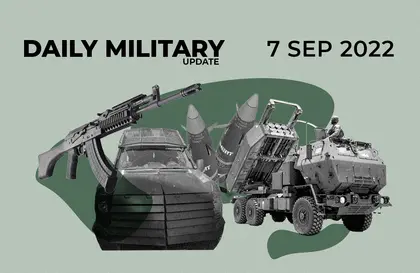Ukraine’s high command has widened its strategy of limited counterattacks in the southern Kherson sector with the assault and capture of an important road intersection town in the southern Kharkiv sector, and the occupation of a tactically-useful bridgehead village in the Donbas sector, news and official reports said on Tuesday, September 6.
One week ago, Ukraine’s Armed Forces (UAF) kicked off a series of local assaults in the southern Kherson sector aimed at capturing villages or expanding bridgeheads on or near the Inhulets River fighting line. The attacks in the Kharkiv and Donbas sectors, launched on Monday, September 5 and continuing the next day, by some measures marked the first significant gains of ground by UAF forces in sectors outside the Kherson region, since April.
Reportedly, Russian Federation (RF) units defending the Russian-occupied town of Balakliya in the Kharkiv sector blew up a nearby bridge over the Voloska Balakliyka River in a failed attempt to stop Ukrainian infantry attacking the town. Some patriotic Russian social media platforms said the UAF assault surrounded and wiped out a special forces police unit from Samara in house-to-house fighting. On the morning of Tuesday, September 6, the Telegram channel balakliya_life posted video of two RF service personnel purportedly killed by UAF fire.
Initial reports of the UAF capture of Balakliya first surfaced on the afternoon of Monday, September 5, with declarations in RF-controlled state media confirming and downplaying the significance of the town’s loss. Vladimir Solovev, a top Kremlin propagandist, in personal social media posts reassured readers saying “it was just local levies holding the village” and “there is no need whatsoever to panic”.

The Wishful Diplomacy of Mad Medvedev – When Progress Isn’t
Colonel Gennady Aleshkin, a military analyst who appears frequently on Russian state-controlled media, in a Tuesday, September 6 article published by the PolitNavigat web magazine said: “No panic, it’s a combat situation, even if Balakliya is lost it won’t be a tragedy.”
According to unconfirmed social media reports on Tuesday, September 6 UAF units had advanced some 15 kilometers north-east from Balakliya and were assaulting the village of Volokhiv Yar. Anatoliy Shariy, a high-profile Ukrainian blogger wanted by Ukrainian authorities for extreme Russian nationalist views, claimed two units of the Samara special police were surrounded and “being destroyed” by UAF attackers.
UAF forces were also on the move in the eastern Donbas sector, with multiple reports, still images and even video of infantry from the UAF’s 79th Air Assault Brigade walking into the village of Stariy Karavan seemingly unopposed. According to some reports, the UAF attack took place on September 2-4 but news of its success was initially blacked out by high command for security reasons.
Stariy Karavan is on the northern/left bank of the Siversky Donets River and, if held by troopers from the 79th , would become a new UAF bridgehead in the Donbas region, a sector that has seen almost unrelenting RF attacks, and effectively no Ukrainian advances, since May.
Ukraine’s Army General Staff (AGS) in a situation report issued on the morning of September 6, said RF units made attack attempts at eight locations in the Donbas sector elsewhere from Stary Karavan, all unsuccessful. The AGS statement offered few details on the progress of UAF advances. In the Kharkiv sector, the report said, in the vicinity of the town of Oleksandrivka, “privately-operated” RF combat units took 40% losses killed and wounded. There was no outside confirmation of the claim.
Vadim Krokhmal, a Ukrainian local deputy from the RF-occupied city of Kupyansk, Kharkiv Region, to the east of Balakliya, hinted at a possible direction for future UAF attacks with a post on the morning of Tuesday, September 6, on the city’s still-functioning metropolitan website.
Residents of the town, a key railhead for RF army supply and logistics, should lay in supplies of food and water, avoid posting information about UAF troop movements, and closely monitor official Ukrainian information platforms for further developments, he said. It was the first official post on the city website in five months. “The VSU (UAF) is already close,” Krokhmal wrote.
You can also highlight the text and press Ctrl + Enter










